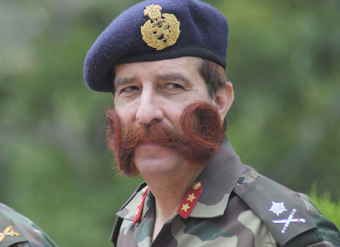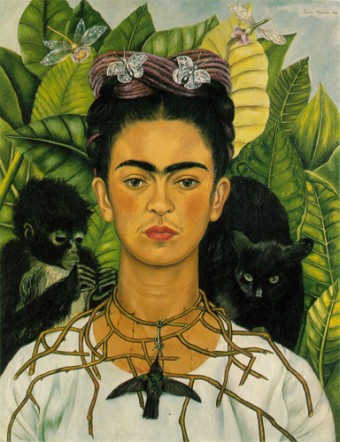From 1860-1916 the Uniform Regulations for the British Army Required Every Soldier to have a Moustache
Today I found out that uniform regulation in the British Army between the years 1860 and 1916 stipulated that every soldier should have a moustache.
Command No. 1,695 of the King’s Regulations read:
The hair of the head will be kept short. The chin and the under lip will be shaved, but not the upper lip…
Although the act of shaving one’s upper lip was trivial in itself, it was considered a breach of discipline. If a soldier were to do this, he faced disciplinary action by his commanding officer which could include imprisonment, an especially unsavory prospect in the Victorian era.
Interestingly, it is during the imperial history of Britain that this seemingly odd uniform requirement emerged. Initially adopted at the tail end of the 1700s from the French, who also required their soldiers to have facial hair which varied depending on the type of soldier (sappers, infantry, etc.), this follicular fashion statement was all about virility and aggression. Beard and moustache growth was rampant, especially in India where bare faces were scorned as being juvenile and un-manly, as well as in Arab countries where moustaches and beards were likewise associated with power. It wasn’t all plain sailing for the moustache though; back home British citizens were looking on it as a sign of their boys ‘going native’ and it was nearly stamped out completely.
However, in 1854, after significant campaigning, moustaches became compulsory for the troops of the East India Company’s Bombay Army. While not in the rules for everyone else yet, they were still widely taken up across the Armed Forces and during the Crimean War there were a wide variety of permissible (and over the top) styles. By the 1860s, moustaches were finally compulsory for all the Armed Forces and they became as much an emblem for the Armed Forces as the Army uniform.
In 1916, the regulation was dropped and troops were allowed to be clean-shaven again. This was largely because such a superficial requirement was getting ignored in the trenches of WWI, especially as they could sometimes get in the way of a good gas mask seal. The order to abolish the moustache requirement was signed on October 6, 1916 by General Sir Nevil Macready, who himself hated moustaches and was glad to finally get to shave his off. While no longer in force today, there are still regulations governing moustaches and, if worn, they can grow no further than the upper lip. It is also still extremely common for British soldiers in Afghanistan to wear beards, as facial hair is still associated with power and authority in many Islamic regions.
If you liked this article, you might also enjoy our new popular podcast, The BrainFood Show (iTunes, Spotify, Google Play Music, Feed), as well as:
- When Humans Started Shaving
- The Leonardo DiCaprio Haircut That Had the Taliban in a Rage
- Shaving Does Not Make Your Hair Grow Back Thicker or Faster
- How to Drastically Increase the Life of Your Shaver Razor Blade Cartridges or Disposable Razors
- The Little Girl Responsible for Lincoln’s Beard
Bonus Moustache Facts:
- As alluded to, during the Napoleonic era, French soldiers were required to wear facial hair of various sorts. Sappers were required to have full beards. Grenadiers and other elite level troops had to maintain large busy moustaches. Infantry Chasseurs were required to wear goatees with their moustache. This requirement has long since died out excepting the case of sappers in the Foreign Legion, who still are strongly encouraged to maintain a full, robust beard.
- Russian non-officer soldiers were required to wear moustaches under Peter the Great’s reign. On the flipside, while previously it was extremely common for Russian soldiers to wear beards, Peter the Great didn’t find beards so great and not only banned them from the military, but also for civilians, with the lone exception being that members of the clergy could wear them.
- Moustache, mustache, and mustachio are all technically correct spellings to describe hair on the upper lip. Mustachio has relatively recently fallen out of favor for generically describing all moustaches, now more typically referring to particularly elaborate moustaches. Moustache is the most common spelling today in the English speaking world, though North Americans usually prefer mustache.
- The English word “moustache” comes from the French word of the same spelling, “moustache”, and popped up in English around the 16th century. The French word in turn comes from the Italian word “mostaccio”, from the Medieval Latin “mustacium” and in turn the Medieval Greek “moustakion”. We now finally get to the earliest known origin which was from the Hellenistic Greek “mustax”, meaning “upper lip”, which may or may not have come from the Hellenistic Greek “mullon”, meaning “lip”. It is theorized that this in turn came from the Proto-Indo-European root “*mendh-“, meaning “to chew” (which is also where we get the word “mandible”).
-
Western Women tend to wax or shave their moustaches, those that can grow them anyways, but Mexican artist Frida Kahlo actually celebrated not only her ‘stache, but also her unibrow, including putting them in her very famous self portrait seen to your right.
- The oldest known depiction of a man with a moustache goes all the way back to 300 BC. The depiction was of an Ancient Iranian horseman.
- “De befborstel” is the Dutch slang for a moustache grown for the specific purpose of stimulating a woman’s clitoris.
- The longest moustache ever recorded was in Italy on March 4, 2010, and measured in at 14 ft. long (4.29 m). The proud owner of that magnificent ‘stache was Indian Ram Singh Chauhan.
- Names of the Various Styles of Moustache:
- Hungarian: Extremely bushy, with the hairs pulled to the side and with the hairs extending past the upper lip by as much as 1.5 cm.
- Dali: Named after artist Salvador Dali (who incidentally once published a book, with Philippe Halsman, dedicated to Dali’s moustache, titled: Dali’s Mustache), styled such that the hair past the corner of the mouth is shaved, but the non-shaved hair is allowed to grow such that it can be shaped to point upward dramatically.
- English Moustache: Thin moustache with the hair on a line in the middle of the upper lip sideways, with the hair at the corner of the mouth slightly shaped upwards.
- Imperial: Includes not only hair from above the upper lip, but also extends beyond into cheek hair, all of which is curled upward.
- Fu Manchu: moustache where the ends are styled downwards, sometimes even beyond the bottom of the chin.
- Handlebar Moustache: a somewhat bushy version of the Dali, but without the strict regulation of having the hair shaved past the side of the lips.
- Horseshoe: Similar to the Handlebar, but with vertical extensions coming off the sides that extend downwards sharply to the jaw, looking something like an upside down horseshoe (think Hulk Hogan)
- Chevron: thick moustache covering the whole of the upper lip (think Jeff Foxworthy)
- Toothbrush: The moustache made popular by Charlie Chaplin, but whose popularity hit a sharp decline thanks to one Adolph Hitler.
- Walrus: very similar to the Hungarian, except without the strict length limit on the hair overhanging the upper lip.
- Contrary to a myth you may hear sometimes, there is no evidence whatsoever that Adolph Hitler decided to grow a toothbrush moustache to mimic Charlie Chaplin. Chaplin did parody Hitler in The Great Dictator and sported the now infamous moustache in that film. The toothbrush moustache was popularized in Germany by Americans and began to become extremely popular by the end of WWI. Hitler originally went with the previous most popular ‘stache in Germany, the Kaiser Moustache, which was turned up at the ends, often with scented oil. He continued to wear this ‘stache at least up to and during WWI. A soldier who served with Hitler during WWI, Alexander Moritz Frey, stated that Hitler was ordered to trim his moustache during WWI while in the trenches to facilitate wearing a gas mask; so shaved the sides off and went with the toothbrush moustache instead.
- Chaplin stated that he used the toothbrush moustache as it looked funny and also allowed him to show his expressions more fully than an alternatively comical moustache that covered more of his face would have.
| Share the Knowledge! |
|







Hi 🙂 On some of the articles the comments are apparent. However, on others, like this one, it just states 13 or whatever comments, but I can’t figure out how to see them. I imagine if I post this comment I should be able to see all the comments; however, how do I access the comments without leaving one?
@flowergirl: This is just a little quirk of this particular wordpress theme. When websites link to an article and have a bit of code installed to ping my site and tell me they did, it ends up counting as a comment. This theme used to show those, but as they add no useful information, I removed that bit of code so they don’t show up and only real comments are displayed.
No, it doesn’t show me the other comments. It says there are 14 comments now but just shows mine.
Okay, thank you. I was thinking something was wrong with me because I couldn’t figure out how to access the comments 😛 I really enjoy your writing, keep up the good work 😀